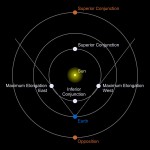There will be a close approach of the Moon and Saturn tonight and tomorrow. At sunset on the 9th the pair will be separated by less than 7° and found well up in the eastern sky. As the night progresses the pair will slowly close the gap. As the pair sets around 03:30 the morning of the 10th, the separation will have been reduced to about 4°. As the two rise on the evening of the 10th they will have passed and the separation will be increasing. At sunset the pair will be 7° apart.
Viewers on the other side of our planet will be able to observe the closest approach, much less than a degree for many, an occultation if you happen to be in the right place. Sky watchers in Capetown, South Africa will see the planet disappear behind the limb of the Moon for about an hour around 19:11UT.

